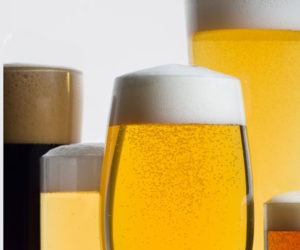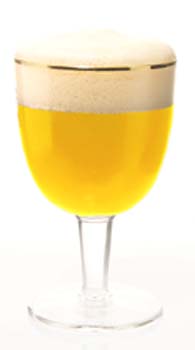Fabulous Foam!
Pop it open. Pour. Fizz. Oh, what a relief it is. That is to have a beer with a frothy head, of course. As homebrewers we like to consider ourselves beer scholars who see beyond appearances and judge beverages on nuances of flavor. It’s time to burst the bubble; the reality is that homebrewers are rather shallow in this regard. We love the looks of a creamy head on a Guinness stout or the Brussels lace left on a glass of Chimay. Why else would marketing-savvy magazine publishers include tempting pictorials of beers topped with prodigious mountains of foam? They know what we like.
Naturally, we also want to produce a good-looking homebrew to impress our friends and family. Understanding what affects beer foam can help you hold your head up high in situations where others fall flat.
Beer foam has a short, tragic existence. It is born, lives, and dies. Like many obsessed homebrewers, its life revolves around beer. The formation of beer head depends largely, but not exclusively, on carbonation, the amount of dissolved carbon dioxide gas (CO2) in beer. Beer can be carbonated naturally by fermentation in a closed container or by forced carbonation. Gas in an unopened bottle of beer is in equilibrium. This means that at any given temperature, the gas pressure in the headspace and the amount of gas dissolved in the beer are constant. When you open a bottle of beer, you create an imbalance between the amount of CO2 in the beer and the amount of CO2 in the atmosphere above the beer. The amount of CO2 in the air is only about 0.2 percent of the total atmosphere, compared with 98 percent in a beer headspace. To restore equilibrium, the CO2 bubbles will leave the beer until balance is restored. That is why an open beer will always go flat over time. Of course agitation and warm temperatures will hasten this process. This phenomenon is demonstrated by opening a thoroughly shaken beer or pouring beer from an over-pressurized or warm keg of beer.
Head Hunting
As a homebrewer, fine tuning carbonation will ensure a good, consitent head. Undercarbonated beer will not form a head, which, in the case of a draft pale ale, may be desirable. If the beer is very overcarbonated, it is more likely to gush, which isn’t desirable for any style of beer.
Carbonation is only one aspect of a good, frothy head. Why doesn’t carbonated water have a head? Beer is a biochemically complex beverage. Within it are compounds that promote beer foam formation and stability and others that detract. Beer foam chemistry and physics can be disturbingly complex, so keep the following in mind. If the promoters win, you have foam. If the detractors win, you have flat beer.
Within beer there are water-loving compounds (hydrophilic) and water-hating compounds (hydrophobic). Beer also has compounds called glycoproteins that are part hydrophilic and part hydrophobic. Imagine a molecule shaped like a tadpole. The head of the molecule hates water, but the tale likes it. When many of these compounds gather together on the top of a beer, the heads group together in a circle (with the tails pointing out) creating a pocket of CO2, naturally forming bubbles.
Many compounds including iso-alpha-acids from hops and certain metal ions help stabilize these structures. However, fats and detergents tend to destabilize the bubbles and cause the foam to collapse. This is why adjuncts that are high in fat including oats and eclectic brewing spices with high oil contents such as coffee beans tend to decrease foam. Also residual soap and detergents in carboys, kegs, and bottles will hurt beer foam. Settling out trub will decrease the amount of fatty acids in the beer. In contrast ingredients that are high in protein and glycoproteins will bolster beer froth. Some of the more common foam-positive ingredients include flaked wheat, flaked barley, wheat malt, and barley malt. Many brewers make a habit of adding a touch of wheat malt to every beer. At low levels the impact on flavor will be small while still imparting foam-positive characteristics.
Mash ingredients that are low in protein such as corn, rice, and sugar adjuncts tend to dilute foam-positive compounds in beer. Malt extracts may lose foam-positive characteristics during processing. The addition of heading powder can counter this problem. Some professional brewers use this additive, an alginate ester, to increase head formation and retention.
Keeping Your Head
Forming a good head is important, but so is keeping it there. This is known as head retention. On of the most important parts of maintaining foam is beer viscosity. Viscosity describes the speed of flow of a liquid. For example maple syrup pours slowly, so we consider it a very viscous liquid.
Beers also have different viscosities. Imagine beer foam as a matrix of bubbles in a liquid. The liquid drains down from the bubbles and back into the beer. Without any liquid surrounding them the bubbles pop and the foam collapses. In a beer with high viscosity, the liquid between the bubbles drains away slowly, so the head lasts longer.
Raw or flaked barley adjunct increases beer viscosity. Some homebrewers occasionally add a pound or two of flaked barley to pale ale type beers and Irish stouts. Beyond increasing head retention, the barley fills out the body of the beer.
Body of Evidence
The final attribute of good foam is the manner in which it clings to the glass. This is aptly refered to as foam cling. Even after the foam has fallen and the beer is finished, the sight of a sudsy latticework on the side of the glass is a fond reminder of a satisfying beer. The iso-alpha acid of hops is said to increase foam cling as are foam-positive compounds in general. However, foam cling may be largely due to the cleanliness of the glass. Foam tends to stick to slightly dirty parts of the glass as it descends. This must be a subtle effect, since a very dirty glass or any soap residue will completely collapse the foam.
Some beers, Guinness in particular, are served with a nitrogen (N2) and carbon dioxide mixture. These beers have a very thick, beady head that seems to last forever. In the case of Irish stout, this is partly due to the high viscosity of the beer. However, N2 is also responsible. N2 gas creates very fine bubbles that are structurally more stable and therefore less likely to burst. Furthermore, N2 gas is somewhat trapped in the foam. Since it is not very soluble in liquid, N2 tends to leave the beer and go directly into the foam. However, keep in mind the idea of equilibrium. The atmosphere is 75 percent N2 as opposed to 0.2 percent CO2, so the N2 gas in the beer foam is not escaping to the atmosphere at any great speed. Consequently, a nitrogen foam is happiest just sitting on top of the beer. To the beer drinker’s delight, this effect is aesthetically pleasing.
Over Your Head
A problem sometimes encountered with beer head is gushing or jumping beer. Most veteran homebrewers have experienced this. You crack open a brew and two-thirds of the beer is all over you and the floor before you manage to reach the sink. Most cases of gushing homebrew are due to overpriming or microbial spoilage in the bottle. Avoid these problems by carefully measuring priming sugar and practicing good sanitation. Technically, malt made from Fusarium (mold) infested barley makes beer that gushes. However, most malt now available shouldn’t cause gushing. Remember the following tips when trying to brew a beer with good head:
- Get your carbonation right.
- Bittering hops are head builders.
- Wheat malt is a natural head booster.
- A small addition of flaked barley will increase head retention.
- Heading compound can increase beer foam.
- Settle out trub.
- Sanitize and rinse well.
- Beware of fats and oils.
- Avoid diluting protein with low-protein adjuncts (corn, rice, sugar).
A nice, frothy head is not just the responsibility of the brewer. The way a beer is poured and the cleanliness of the glassware are just as important. Also, keep in mind that the way a beer looks is never as important as how it tastes. Not every beer you make will look glamorous. Most important is how you like it. If you want to add greasy coffee beans or Fruity Pebbles to the mash and you are happy with headless beer, then more power to you.
Strategies in the Foam Game
- Awesome Foam — for the brewer in search of drop-dead head
- Brew all-malt beer (no adjuncts such as rice, corn, or sugar); made from all-grain brewing.
- Use foam-building ingredients such as wheat or unmalted barley.
- Carbonate to a slightly higher level or use a nitrogen stout gas.
- Use scrupulously clean glassware.
- Leave no chemical residue on any brewing equipment, beer bottles, beer glasses, or body parts.
- Foam suffers from the thought of some chemicals.
- Brew hefeweizen, wit beer, and stout (dispensed through a stout tap). These three styles have naturally awesome foam.
- Good Foam — for the brewer who wants a good head without jumping through hoops
- Brew all-malt beer (no adjuncts such as rice, corn, or sugar) made from all-grain brewing. Extracts lose much of the foam-building proteins during processing.
- Use a generous addition of hops. Hop bittering acids help foam cling.
- Properly carbonate so the foam has enough gas to form correctly.
- Thoroughly rinse your equipment but don’t obsess — no-rinse sanitizers are acceptable for the brewer in search of good foam.
- Bad Foam — some of the most common culprits to avoid
- Excessive use of adjunct ingredients. Ever see an American-style lager with awesome foam?
- Very, very little hops. Light beers with low hopping rates have bad foam!
- Fats and oils — oats, coffee, chocolate, potato chips, and the like all contain fats and oils. Avoid the use of such ingredients if you want good foam. If you want chocolate porter more than foam, then don’t worry — you may get lucky and have good foam.
- Foaming cleaners and sanitizers. Detergents destroy beer foam even though they are foamy themselves. These compounds must be rinsed off of all brewing equipment.
- Foaming the beer before drinking. Once a foam forms, the foaming compounds do not form foam a second time.
- Flat beer doesn’t foam unless it is dispensed using special taps (beer engines for example).


